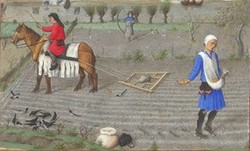A Scene from the Beautiful Luttrell Psalter
Dear S2Z,
Menial work. Grinding toil. Constant struggle for a substantial proportion of the population.
You may think I’m describing your life at high school (at least when all your assignments are due at once), but actually I’m referring to the peasants of medieval Europe.

Image kindly provided by http://retrokat.com/medieval
Even in such a lowly group as the peasants, who made up the bottom 90 per cent of the population, there were variations in status. Some were free and some were serfs. A serf was like a slave but not quite a slave.
According to the Shorter Oxford, a serf was “a person in a condition of servitude or modified slavery”. Even though the powers of the master were “more or less limited by law or custom”, in reality the master had great power, if he chose to wield it.
Servitude meant that the serfs were subject to the will of the lord of the manor; they could not leave the manor without his permission. They were subjugated, they were poor, they were often hungry; to get through each year would have required unimaginable struggle, grinding toil and a fair bit of luck.
 Hunger was a constant danger, starvation a real possibility. According to Lacey and Danziger, the writers of The Year 1000: What Life was Like at the Turn of the First Millennium, July in England was the toughest month. The spring crops had not yet matured; the midsummer harvest produced hay for the animals and nothing for the humans. This time was referred to as “the hungry gap”.
Hunger was a constant danger, starvation a real possibility. According to Lacey and Danziger, the writers of The Year 1000: What Life was Like at the Turn of the First Millennium, July in England was the toughest month. The spring crops had not yet matured; the midsummer harvest produced hay for the animals and nothing for the humans. This time was referred to as “the hungry gap”.
Yet there were some healthy aspects of their lifestyle. They had a very healthy diet, if only they could get enough of it. They lived on a pottage (like a porridge) of grain and vegetables, into which they dipped the hard, coarse and often stale flat bread that they baked. No soft, fluffy bread for them: their bread was a little like a pita bread or nan, but tougher and coarser. The pottage served to soften the hard, stale bread and make it edible. The bread was also used as an edible plate, called a “trencher”.
 A detail from the beautiful 15th century Book of Hours (in the public domain from about.com) called Les Tres Riches Heures du Duc de Berry. This shows October – tilling and sowing.
A detail from the beautiful 15th century Book of Hours (in the public domain from about.com) called Les Tres Riches Heures du Duc de Berry. This shows October – tilling and sowing.
One of the healthiest aspects of their diet was that they had no sugar. Until the 17th century, when sugar was brought back from the Caribbean, no one in England had sugar. Honey was so precious that it was sometimes used as a currency. The positive aspect of a life without sugar is that the people at that time experienced almost no dental or jaw decay. The skeletal remains of the Anglo-Saxons in the year 1000 show that they were surprisingly tall, with excellent teeth.
Below are some extra details about their lives, with some websites for you to explore. Don’t work too hard. I don’t want you to feel like serfs.
On the other hand, perhaps that’s not such a bad idea…
Kind regards,
Ms Green
Did you know…?

Medieval peasants worked long hours, produced most of the food and paid most of the taxes. If you want justice, don’t expect to find it in the medieval world.

Peasants’ cottages had dirt floors and walls made of mud, cow dung and straw. There was no glass in their windows and their animals often lived with them.

Fleas were common. People expected to have them.

Many peasants died in the winter from hypothermia.

Outer clothes were rarely washed but wood smoke acted as a kind of deodorant.

It has been estimated that 20% of women died in childbirth. Infant mortality was also high.
CLICK ON THESE SITES TO DISCOVER MORE…
General details of peasant life:
Bitesize: BBC Website on Life in a Medieval Village
Peasant life and housing with pictures of cruckhouses: http://www.historylearningsite.co.uk/medieval_peasants.htm
A famous and beautiful illuminated manuscript:

